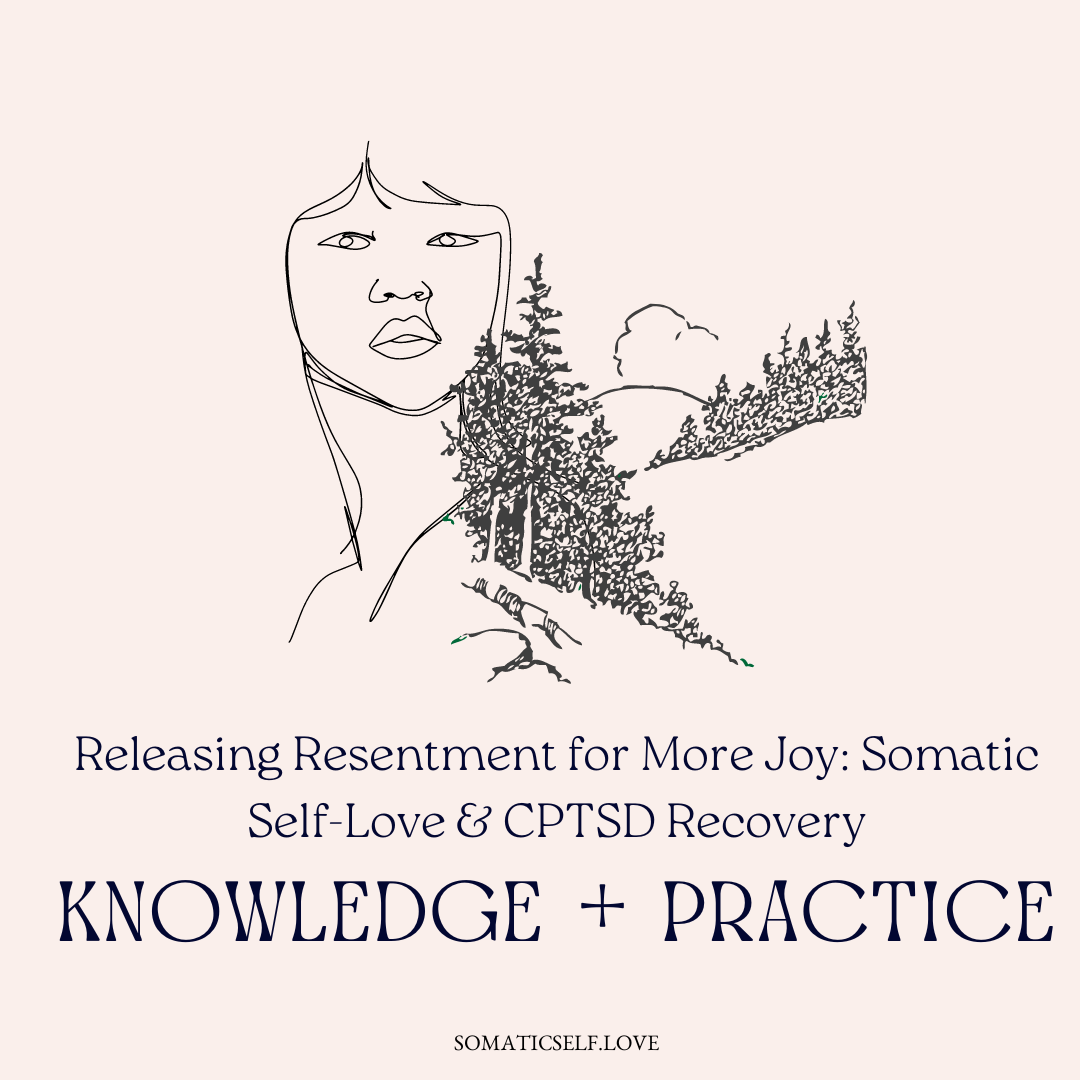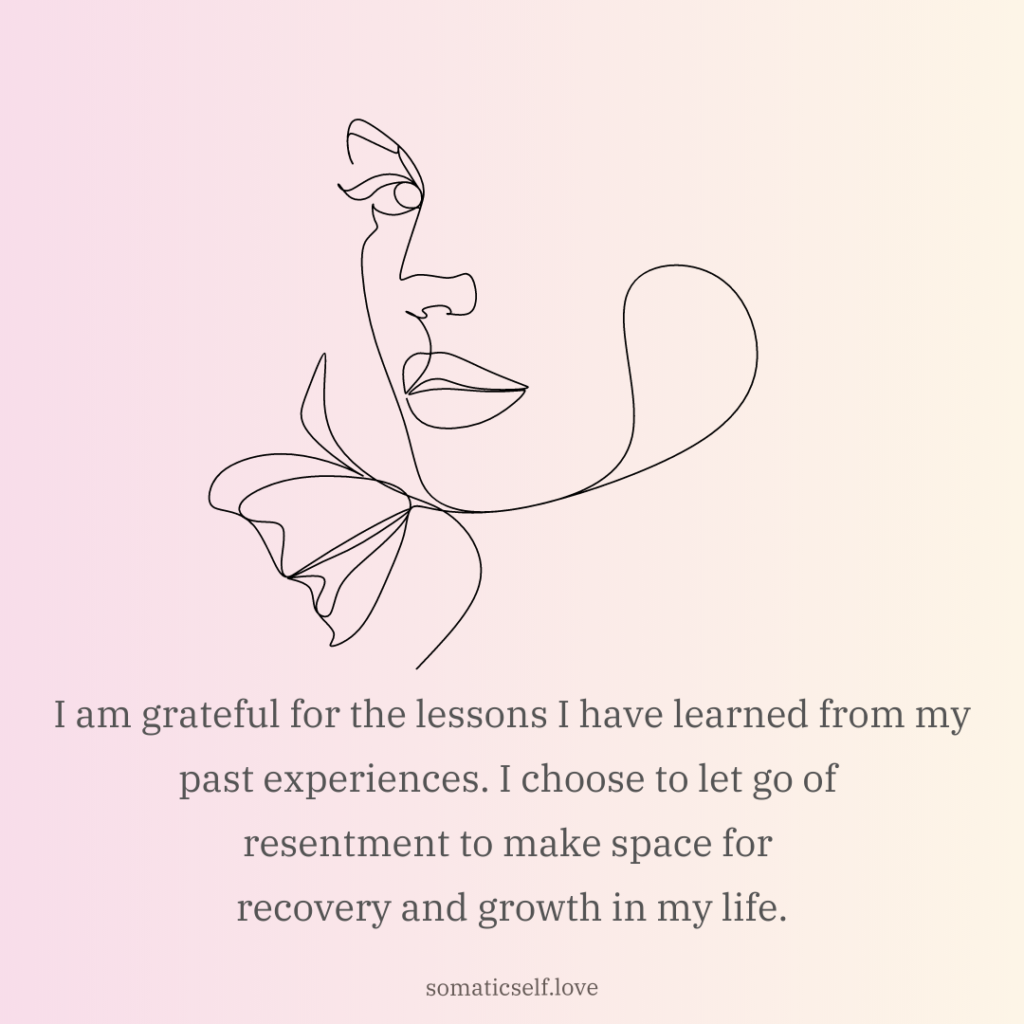Releasing Resentment for More Joy: Somatic Self-Love & CPTSD Recovery

Abuse and any mistreatment can lead to intense resentment, but it doesn’t have to be that way. Learn how somatic self-love and recovery from CPTSD can help you move forward and release resentment so you can find more joy in life...
For those of us who experienced childhood abuse, resentment can feel “good.” When we’ve been wronged, the adrenaline rush of righteous anger can feel warranted and empowering, making it extremely difficult to see the high cost of harboring resentment and working toward giving it up. This powerful emotion can feel like a way to hold onto a sense of justice or control and can be used as a shield against further harm.
Comes at a High Cost
Carrying resentment can sometimes feel like a way to protect ourselves from future harm by keeping us on guard and preventing us from being vulnerable. Resentment can be a way of holding onto past hurts and injustices, and can make us feel like we are in control of the situation by holding onto our anger and not letting go.

However, while resentment may provide a temporary feeling of safety or control, it can ultimately be harmful to our mental and emotional well-being. Holding onto resentment can lead to feelings of bitterness, anger, and negativity, and can prevent us from moving on and finding peace and happiness in our lives.
It’s important to recognize that holding onto resentment does not actually keep us safe, but rather holds us back from experiencing positive emotions and growth. By letting go of resentment, we can create space for positive change and growth in our lives, and can open ourselves up to new experiences and relationships that can bring us happiness and fulfillment.
It’s important to acknowledge that letting go of resentment is not always easy, and may require time and effort to work through. It can be helpful to seek out the support of a therapist or counselor who can help you work through these difficult emotions and find healthy ways to move forward.
Here are some steps that can help in letting go of resentment:
- Acknowledge the resentment: Acknowledge the resentment and the feelings associated with it. It’s important to validate your own emotions and experiences and to acknowledge that it’s okay to feel angry or hurt.
- Identify the source: Identify the source of the resentment. This may involve reflecting on past experiences of childhood abuse or other traumas and understanding how these experiences have shaped your beliefs and attitudes.
- Practice self-compassion: Practice self-compassion by acknowledging that holding onto resentment can be a coping mechanism but may not serve you in the long run. Be kind to yourself and remind yourself that you deserve healing and happiness.
- Practice forgiveness: Practice forgiveness, not for the benefit of the person who wronged you, but for your own benefit. Forgiveness can help to release the grip of resentment and promote healing.
- Seek support: Seek support from a therapist or support group who can provide a safe space for you to process your emotions and experiences and who can help you to develop strategies for letting go of resentment.
Overall, letting go of resentment is a process that takes time and effort. It’s essential to be patient and kind to yourself and to seek support from others when needed. By acknowledging the resentment, identifying the source, practicing self-compassion, practicing forgiveness, and seeking help, you can begin to release the grip of resentment and move toward healing and growth.
Begin with a Shaking Practice
This is a shaking practice for cultivating somatic self-love and releasing resentment:
- Find a private and quiet space where you feel comfortable to move freely. Stand with your feet hip-width apart and close your eyes.
- Begin to shake your body from your feet up to your head. Let your arms and legs shake freely as you allow the shaking to increase in intensity.
- As you shake, focus on releasing any tension or resentment you may be holding in your body. Allow yourself to feel any emotions that come up, and let them pass through you without judgment.
- Take deep breaths in through your nose and out through your mouth, allowing your breath to support the shaking and release of tension.
- Continue shaking for several minutes, allowing your body to move in whatever way feels natural and comfortable.
- When you feel ready, slowly bring the shaking to a stop and stand still for a few moments, taking deep breaths and noticing any sensations in your body.
- Take a moment to reflect on any emotions or sensations that came up during the shaking practice. Journaling or talking with a trusted friend or therapist can be helpful in processing these emotions and releasing any lingering resentment.
Remember, shaking is a powerful tool for releasing tension and promoting emotional regulation. It’s crucial to approach shaking with an open and curious mindset, and to allow yourself to feel whatever emotions come up without judgment. With regular practice, shaking can be a powerful tool for promoting somatic self-love and releasing resentment.
Self-Love Ceremony for Releasing Resentment
Here is a somatic self-love ceremony for releasing resentment:
- Set the space: Find a quiet and comfortable space where you won’t be interrupted. You might want to light some candles or incense to create a calming atmosphere.
- Light a candle: as you light the candle, ask the element of fire to help you light the flame of self-love within you.
- Ground yourself: Sit or lie down in a comfortable position and close your eyes. Take a few deep breaths, and focus on the sensation of your breath moving in and out of your body. Feel your body sinking into the surface beneath you, and imagine roots extending from your body into the ground, anchoring you in the present moment.
- Tune into your body: Tune into your body by scanning your body from head to toe, noticing any areas of tension, discomfort, or pain. Take a deep breath into each area of tension, imagining the breath flowing into that area and releasing the tension as you exhale.
- Resource: link to Somatic Self-Love Resourcing
- Express your resentment: Take some time to express your resentment. You might want to write a letter to the person who wronged you or simply speak out loud about the feelings of anger or hurt that you’ve been holding onto. Give yourself permission to express your emotions without judgment or shame.
- Feel the emotions that come up:
- Offer yourself acceptance: Accept what happened, not for the benefit of the person who wronged you, but for your own benefit. You might want to repeat a mantra, such as “I accept what happened, and I release this resentment,” or “I forgive myself for holding onto this resentment.” Allow yourself to feel the emotions that come up as you enter into acceptance, and remind yourself that this is a process that takes time.
- Release the resentment: Release the resentment by visualizing it leaving your body. You might want to imagine the resentment as a dark cloud or heavy weight that is leaving your body or simply imagine it dissolving into the air around you. Take a deep breath and imagine yourself filling up with love and compassion.
- Close the ritual: express gratitude to yourself and your body for being in this space. As you blow out the candle, thank the element of fire for the light it provided – bringing the resentment into the light.
- Practice self-love: Practice somatic self-love by taking some time to care for yourself. You might want to take a warm bath, go for a walk in nature, or simply take a few moments to appreciate your own strength and resilience. Remind yourself that you deserve healing and happiness.
Overall, this somatic self-love ceremony can help to release the grip of resentment and promote healing. By grounding yourself, tuning into your body, expressing your resentment, offering acceptance, releasing the resentment, and practicing self-love, you can cultivate a greater sense of self-compassion and self-acceptance and move toward recovery and growth.